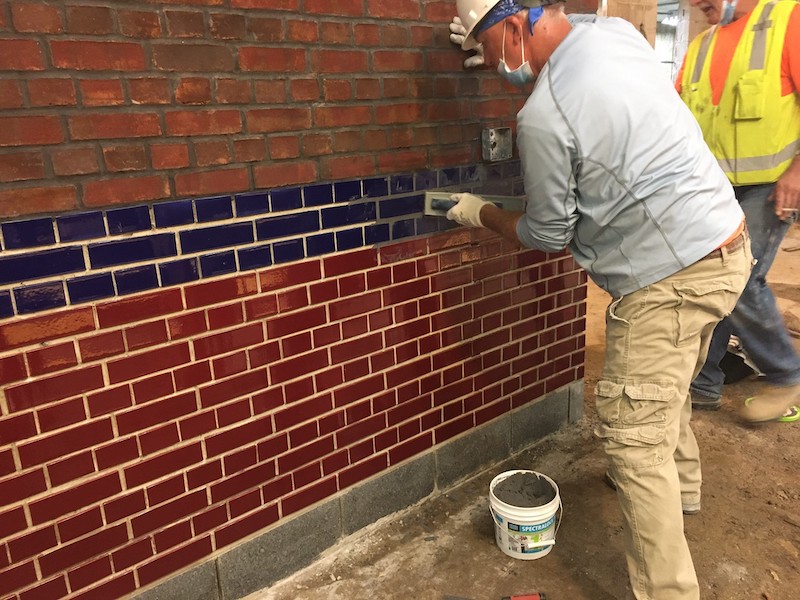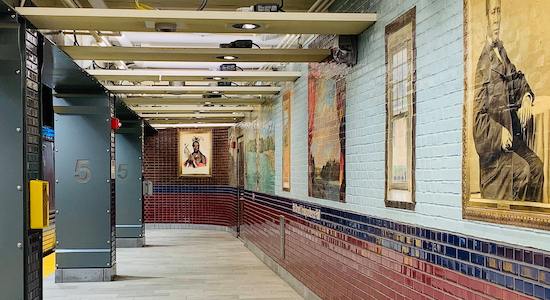Originally opened in 1908, the 5th Street/Independence Hall Station, served by The Southeastern Pennsylvania Transportation Authority (SEPTA)’s Market-Frankford Line, is an iconic subway terminal in the heart of Philadelphia’s Historic District. The terminal provides access to some of the most notable landmarks in the nation such as Independence Hall, the Liberty Bell, the National Constitution Center, the National Museum of American Jewish History and the Philadelphia Bourse. With the last renovation of the station conducted in 1976, SEPTA’s goal was to further transform the 68,000-sq. ft. (6,317 m2) space into a modern transportation hub while also capturing the rich history in the area which the station serves.
The new renovation required the removal of all existing wall finishes on the structural concrete and existing masonry walls to make room for the new architectural design. The project also entailed a complete restoration of the building’s infrastructure, mitigation of the water infiltration and a complete repair of the structural cracks and spalls from years of neglect. The masonry aspect of the project included new wall layouts using concrete masonry units (CMU) and alterations to existing concrete walls to allow for new thin-brick and full-bed brick, mosaic tile and granite.

Once construction started, SEPTA’s construction manager, AP Construction, brought in DM Sabia & Co. Inc. to handle the masonry renovation and new masonry construction. Despite delays and long lead times the construction industry was facing, DM Sabia’s team strategically curated a team of local Philadelphia professionals that could successfully complete the project on a major time crunch. Knowing they needed best-in-class masonry setting materials and products that could withstand the harsh temperature fluctuations, intense impact and vandalism, the team selected LATICRETE as their chosen manufacturer.
“Quality of workmanship starts with quality in manufacturing. In collaboration with LATICRETE, we knew we could further expedite the installation by utilizing their setting materials,”said John Giungo, DM Sabia Project Executive.


The challenges
• Tight Turnaround Time: The team was responsible for renovating the train station in the middle of the COVID-19 pandemic while it continued to be a fully-functioning mass transit terminal. DM Sabia needed the products expedited from the original 32-week lead time for masonry materials. The urgency of the masonry schedule required rethinking how decisions would be made and diligent collaboration of all parties to get the station completed on time.
• High Visibility: Thousands of residents and tourists utilize the terminal daily. It was key to design a long-standing space that captured the historic look and heritage of the area, while updating it for the modern commuter.
• Harsh Conditions: Since the 1976 renovation, the station had experienced decades-worth of damage from constant use, vandalism, intense pressure-washing and moisture problems caused by Philadelphia’s fluctuating temperatures. This excessive wear and tear required deconstructing and leveling out the concrete walls.
LATICRETE solutions include fast-tracking two brand-new products
The high-caliber setting materials and services offered by LATICRETE were essential to tackle these challenges and ensure a long-lasting result that could be enjoyed by passengers for decades to come. To this end, the LATICRETE team worked with Joe Lawless at distributor Emser Tile to successfully fast-forward the production of two completely new products: LATICRETE® 3701 Lite Mortar and SPECTRALOCK® 1. The product order encompassed more than 1,000 buckets of SPECTRALOCK 1 alone, which would remain the company’s largest order of SPECTRALOCK 1 for years to come.
Since both 3701 Lite Mortar and SPECTRALOCK 1 had not been fully introduced to the market at this point, the LATICRETE team attended various construction meetings where they performed on-site demonstrations and training. The technical services team also remained on call around the clock, working after hours to help approve designs and streamline any unforeseen obstacles when deconstruction began.


Once the teams deconstructed the existing walls of the terminal, 3701 Lite Mortar was applied, which is the industry’s first lightweight, rapid mortar that offers high-performance characteristics and enhanced durability. The 3701 Lite Mortar formula is composed of carefully-selected polymers, Portland cement and lightweight aggregates. It does not require the use of a latex admixture – only water – and contains no respirable crystalline silica levels that exceed the OSHA action level*. The 3701 Lite Mortar has excellent performance in vertical and overhead applications, such as concrete repairs or wall renders, making it the ideal solution for the 5th Street/Independence Hall Station. As an added bonus, its lightweight feature makes it easier and safer to transport and handle on the job site.
After the interior walls were prepped and leveled out, the new SPECTRALOCK 1, a pre-mixed, stain-proof grout with the compressive strength performance of epoxy grout was employed to help further accelerate the overall installation of the thin brick and mosaic tile. SPECTRALOCK 1 offers superior compressive strength at 3,500 psi (24.1 MPa), the ability to be submerged and an extremely fast cure rate so that customers can complete durable projects in less time than ever before. SPECTRALOCK 1 is simple to maintain and use, safe to use with no epoxy resins and is offered in a wide variety of colors to match any design.


In addition to SPECTRALOCK 1 grout, the glazed brick and mosaic wall tile within the station were installed with 254 Platinum, an ultimate one-step, polymer-fortified, thin-set mortar for interior and exterior installations. Providing optimum adhesion, 254 Platinum offers incredible bond strength to concrete and has a long open time in a smooth, creamy formula.
“From our industry-leading solutions to our technical service support and everything in between, this project came together tremendously and showcased our team’s ability to be resilient even under pressure and challenging circumstances,” said Brian McMahon, LATICRETE Assistant Regional Sales Manager.
Paying homage to history, with a modern twist
Used by more international tourists than any other station in the SEPTA system, the newly-renovated 5th Street/Independence Hall Station terminal has been celebrated as a premier modern transportation hub that successfully pays homage to the history of the city it serves.



“The job went off without a hitch. The value of the choices made on this project allowed the city of Philadelphia to receive an everlasting, artistic train terminal at the heart of some of the nation’s most iconic landmarks,” concluded Giungo.
Included in the award-winning design by Converse Winkler Architecture LLC and Burns Engineering, the new brick walls in the station showcased mosaic tile from Jessica Liddell, Mosaic Artist at Bella Mosaic Art. She was commissioned to produce 12 identification signs and eight exit signs that were integrated into the brick layout. Kbonk Arts collaborated with DM Sabia in the replication of the 5th Street Independence Hall insignias, which sat in the middle of the commissioned historical artwork, “Portal” by Philadelphia artist Tom Judd that lines the station platform walls.



*OSHA action level set forth in OSHA’s Respirable Crystalline Silica (RCS) standard for construction, 29 CFR 1926.1153, as certified by an independent laboratory to be below the OSHA action level for respirable crystalline silica – see www.laticrete.com/silica







